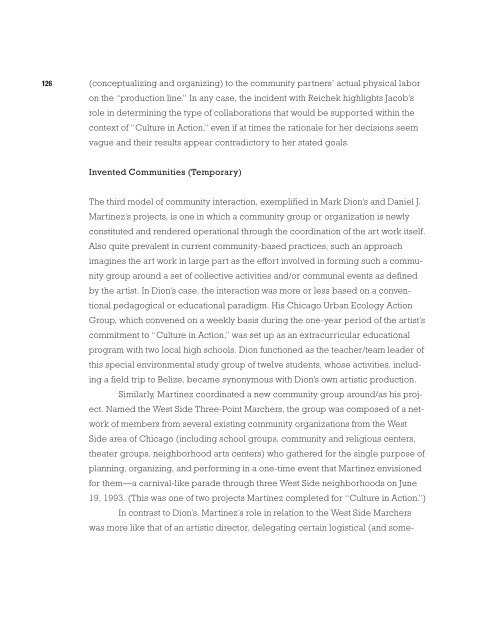ONE PLACE AFTER ANOTHER - Monoskop
ONE PLACE AFTER ANOTHER - Monoskop
ONE PLACE AFTER ANOTHER - Monoskop
You also want an ePaper? Increase the reach of your titles
YUMPU automatically turns print PDFs into web optimized ePapers that Google loves.
126<br />
(conceptualizing and organizing) to the community partners’ actual physical labor<br />
on the “production line.” In any case, the incident with Reichek highlights Jacob’s<br />
role in determining the type of collaborations that would be supported within the<br />
context of “Culture in Action,” even if at times the rationale for her decisions seem<br />
vague and their results appear contradictory to her stated goals.<br />
Invented Communities (Temporary)<br />
The third model of community interaction, exemplified in Mark Dion’s and Daniel J.<br />
Martinez’s projects, is one in which a community group or organization is newly<br />
constituted and rendered operational through the coordination of the art work itself.<br />
Also quite prevalent in current community-based practices, such an approach<br />
imagines the art work in large part as the effort involved in forming such a community<br />
group around a set of collective activities and/or communal events as defined<br />
by the artist. In Dion’s case, the interaction was more or less based on a conventional<br />
pedagogical or educational paradigm. His Chicago Urban Ecology Action<br />
Group, which convened on a weekly basis during the one-year period of the artist’s<br />
commitment to “Culture in Action,” was set up as an extracurricular educational<br />
program with two local high schools. Dion functioned as the teacher/team leader of<br />
this special environmental study group of twelve students, whose activities, including<br />
a field trip to Belize, became synonymous with Dion’s own artistic production.<br />
Similarly, Martinez coordinated a new community group around/as his project.<br />
Named the West Side Three-Point Marchers, the group was composed of a network<br />
of members from several existing community organizations from the West<br />
Side area of Chicago (including school groups, community and religious centers,<br />
theater groups, neighborhood arts centers) who gathered for the single purpose of<br />
planning, organizing, and performing in a one-time event that Martinez envisioned<br />
for them—a carnival-like parade through three West Side neighborhoods on June<br />
19, 1993. (This was one of two projects Martinez completed for “Culture in Action.”)<br />
In contrast to Dion’s, Martinez’s role in relation to the West Side Marchers<br />
was more like that of an artistic director, delegating certain logistical (and some-

















